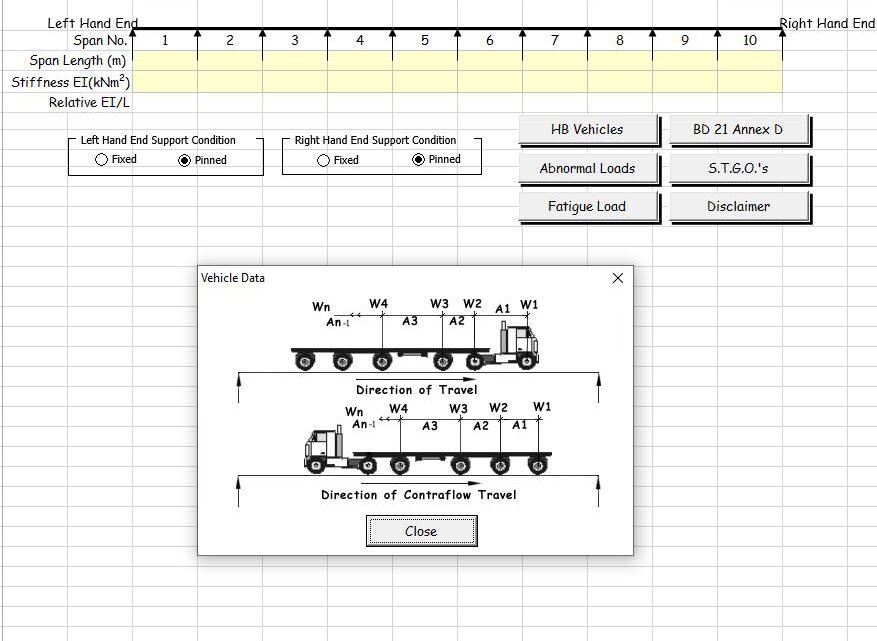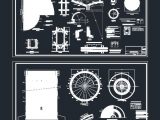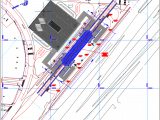
Line Beam Analysis for Moving Vehicle Loads to BS 5400, BD 21 and BD 86 Spreadsheet
5 May 2025Table of Contents
Line Beam Analysis for Moving Vehicle Loads to BS 5400, BD 21 and BD 86 Spreadsheet
What is Line Beam Analysis?
Line Beam Analysis is a method used to study the structural response of a beam when subjected to loads moving across it. Rather than modeling the full 3D geometry of the structure, engineers represent the beam as a simplified line with flexural stiffness and boundary conditions. This method is particularly effective for long-span bridges, elevated highways, and railway tracks.
The goal is to evaluate:
-
Bending moments
-
Shear forces
-
Deflections
-
Support reactions
…as vehicles move along the beam’s span.
Why Is Line Beam Analysis Important for Moving Vehicle Loads?
Moving loads such as cars, trucks, or trains impose dynamic forces on a structure. Unlike static loads, these forces vary in magnitude and position over time, introducing complex challenges in design and safety evaluation.
Key reasons to perform line beam analysis for vehicle loads include:
-
Designing for maximum stress conditions
-
Ensuring structural safety and serviceability
-
Identifying critical load positions
-
Predicting fatigue due to repetitive vehicle movement
-
Complying with codes like AASHTO, Eurocode, or local regulations
How Engineers Perform Line Beam Analysis
Engineers use specialized software or custom spreadsheets to simulate moving vehicles as point or distributed loads. They model:
-
Vehicle weight and axle spacing
-
Beam properties (length, stiffness, support type)
-
Load positions over time or distance
-
Impact factors and load combinations
Using tools like influence lines, they determine which locations on the beam experience the highest stress under various vehicle configurations. This data is critical for sizing structural members and checking load-bearing capacity.
Applications of Line Beam Analysis
Line beam analysis isn’t limited to bridges. It applies to various real-world structures, such as:
-
Highway and railway bridges
-
Elevated viaducts
-
Runways and taxiways
-
Industrial loading platforms
-
Tunnels and underground structures with vehicular traffic
It allows engineers to predict and mitigate structural issues before they arise, improving long-term performance and minimizing costly maintenance.
Benefits of Using Line Beam Analysis
-
Efficiency: Fast and straightforward compared to full finite element modeling
-
Accuracy: Sufficiently precise for preliminary and detailed design stages
-
Cost-effective: Reduces computational resources and time
-
Versatile: Adapts to various vehicle types and load scenarios
Common Software for Line Beam Analysis
Several engineering tools offer line beam analysis for moving loads, including:
-
MIDAS Civil
-
CSI Bridge
-
SAP2000
-
STAAD.Pro
-
Excel-based spreadsheets (custom-developed by engineers)
These tools help automate calculations and visualize how beams react under a range of loading conditions.
Conclusion
Line Beam Analysis for Moving Vehicle Loads is a foundational technique in structural engineering, especially for bridge and highway design. It enables engineers to simplify complex loading scenarios into manageable analyses that still capture the critical behavior of the structure.
Whether you’re a civil engineering student, a practicing structural engineer, or managing infrastructure projects, understanding how to apply line beam analysis will significantly improve your ability to deliver safe, efficient, and durable designs.


